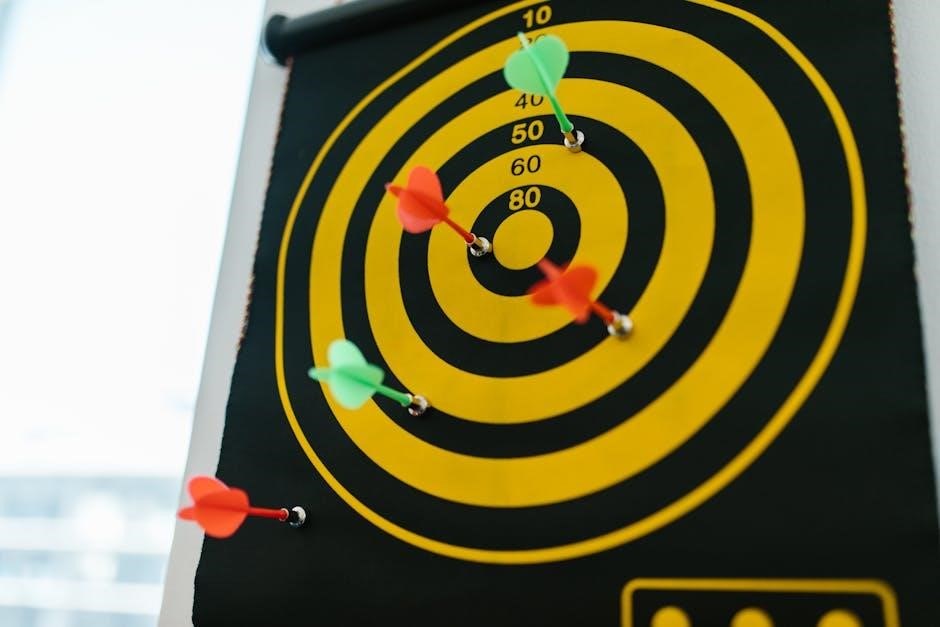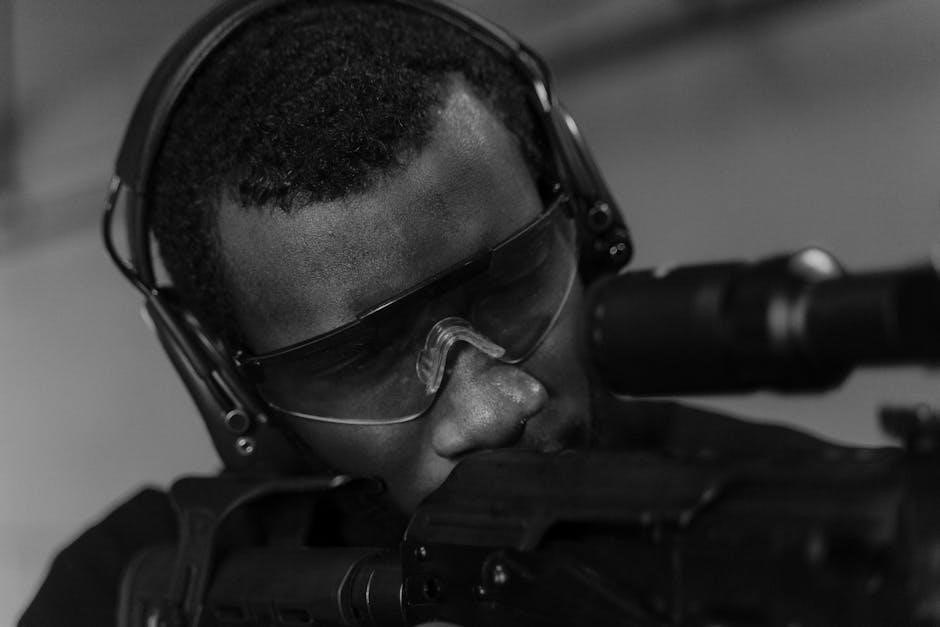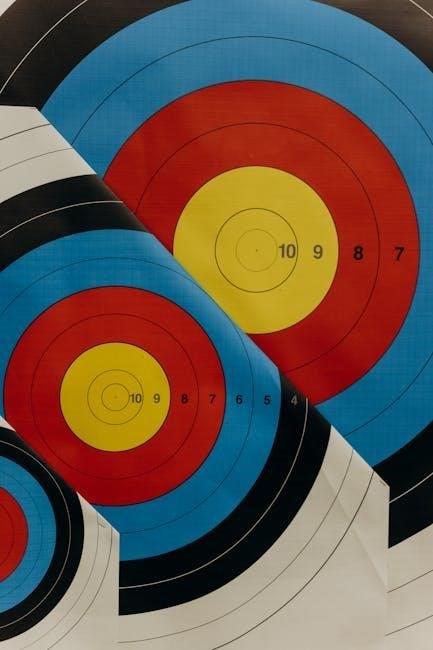
Honda LaneWatch is an innovative driver-assistance system using a camera in the passenger-side mirror to enhance visibility. The aiming target is essential for accurate calibration, ensuring proper camera alignment and functionality.
1.1 Overview of Honda LaneWatch System
The Honda LaneWatch system is a driver-assistance technology designed to improve visibility by displaying a live camera feed from the passenger-side mirror. This feature helps reduce blind spots, especially when changing lanes or parking. The system relies on precise calibration using a specially designed aiming target, typically a 36×48 inch pattern printed on durable materials. Proper alignment ensures accurate camera functionality, while the target’s size and color match specifications guarantee reliable performance. Users can access setup guides and diagnostic menus to fine-tune the system, ensuring optimal safety and convenience on the road.
1.2 Importance of Calibration for LaneWatch
Calibration is essential for the Honda LaneWatch system to ensure accurate and reliable performance. Proper alignment of the camera with the aiming target guarantees clear and distortion-free images, crucial for safe driving decisions. Misalignment can lead to inaccurate representations, potentially causing safety hazards. Regular calibration is necessary, especially after servicing or accidents involving the camera, to maintain system integrity and integration with vehicle software. It also enhances user experience by providing a clear and reliable image, reducing distractions and ensuring compliance with safety standards.

Understanding the Aiming Target
The aiming target is a specialized tool designed to assist in calibrating the Honda LaneWatch system. It helps ensure proper camera alignment and accurate image display.
2.1 Design and Purpose of the Aiming Target
The aiming target is a specially designed pattern used to calibrate the Honda LaneWatch system. Its design features a grid and reference points that help align the camera accurately. The purpose is to ensure the system captures the correct field of view and processes images properly. The target’s layout is precise, making it essential for achieving optimal system performance and reliable blind-spot monitoring. It is typically printed on paper or cardboard and placed in a specific location relative to the vehicle during calibration.
2.2 Dimensions and Specifications of the Target
The aiming target is specifically designed with precise dimensions to ensure accurate calibration. It typically measures 8.5 x 11 inches, matching standard paper sizes for easy printing. The grid pattern and alignment markers are sized to fit the camera’s field of view. The target must be printed without scaling to maintain its proportions. Proper orientation (portrait) and high-resolution printing are crucial for clarity. The design ensures the camera can detect reference points accurately, making it essential to use the correct material, such as thick paper or cardboard, for durability and clear visibility.
2.3 Material and Construction of the Target
The aiming target is typically printed on high-quality paper or sturdy cardboard for durability. It is recommended to use materials with a smooth finish to ensure clear visibility. The target’s grid and markers must be printed with vibrant, high-contrast colors to enhance camera detection. Avoid laminating the target, as reflections may interfere with the calibration process. Using thick, non-glossy paper helps maintain the target’s stability and prevents bending. Proper material selection ensures the target remains legible and functional during the calibration process.

Printing the Aiming Target
Download the official Honda LaneWatch aiming target PDF. Print it using a high-resolution printer on standard A4 or letter-sized paper. Ensure the print size is set to actual size for accuracy.
3.1 Downloading the PDF Template
To begin the calibration process, locate and download the official Honda LaneWatch aiming target PDF. Visit Honda’s official website or authorized dealer portals for the correct template. Ensure the file is specifically designed for your Honda model for accurate calibration. Save the PDF to a convenient location on your device. Verify the file is not corrupted and opens properly before proceeding. This step ensures you have the precise pattern needed for the LaneWatch system to function correctly. Always use the latest version available for optimal results.
3.2 Printing Requirements and Recommendations
Print the Honda LaneWatch aiming target PDF on high-quality, matte-finish paper to ensure clarity. Use a printer with high resolution for precise details. Set printer settings to “Actual Size” or “100%” to avoid scaling issues. Print in portrait orientation as specified. Use a laser printer for sharper lines and accurate colors. Avoid glossy paper to reduce glare. Verify the target’s size and color accuracy before use. Ensure no scaling adjustments are made during printing, as this could affect calibration. Proper printing is crucial for the system to function accurately.
3.3 Ensuring Accurate Size and Color
To ensure the aiming target is correctly calibrated, verify its size and color accuracy. Use a ruler to measure the target’s dimensions, ensuring they match the specified requirements. Print a test page to confirm the aspect ratio and color representation. Natural lighting is recommended for accurate color perception. If possible, use a color-calibrated printer or display to match the PDF’s color profile. Ensure no scaling occurs during printing, as this could distort the target’s dimensions and affect calibration accuracy. Proper size and color alignment are critical for the LaneWatch system to function correctly.

Setting Up the Aiming Process
Position the vehicle on a level surface and attach the aiming target to the rear bumper or specified location. Ensure the camera is aligned properly.
4.1 Preparing the Vehicle and Environment
To prepare for the aiming process, ensure the vehicle is on a level surface and apply the parking brake. Check that the tire pressure matches the manufacturer’s specifications for accurate camera alignment. Clean the rearview camera lens and surrounding area to avoid interference. Position the vehicle in an open space with no obstructions behind it. Ensure the aiming target is printed to the correct dimensions and securely attached to the specified location. Turn off any electronic devices that may cause interference and ensure the environment is well-lit for optimal visibility.
4.2 Positioning the Target
Mount the aiming target on the rear bumper or designated area, ensuring it is centered and aligned with the vehicle’s centerline. The target must be at a height of approximately 20 inches from the ground to match the camera’s viewing angle. Ensure the target is level and securely attached to prevent movement. Double-check the target’s position relative to the rearview camera to ensure proper alignment. Refer to the PDF instructions for precise placement guidelines to guarantee accurate calibration of the LaneWatch system.
4.3 Adjusting the Camera Angle
To adjust the camera angle for the Honda LaneWatch system, start by accessing the camera settings through the infotainment screen. Navigate to the diagnostic or setup menu, where you can find options for camera orientation. Use the touchscreen or physical buttons to make precise adjustments, checking the display after each change to ensure the view aligns correctly. Ensure the aiming target is properly positioned before adjusting. After making adjustments, save the settings and test the system by driving to confirm accurate functionality. If issues arise, consult the PDF guidelines or a Honda technician for assistance.

Calibrating the LaneWatch System
Calibration ensures the LaneWatch system functions accurately. Use the aiming target to align the camera, then follow on-screen instructions to complete the process successfully.
5.1 Accessing the Diagnostic Menu
To access the diagnostic menu for Honda LaneWatch calibration, turn the ignition to the ON position. Navigate to the infotainment system, select “Settings,” then “Vehicle Settings,” and choose “Diagnostic Menu.” From there, scroll to “LaneWatch Calibration” and follow the on-screen instructions to begin the process. Ensure the aiming target is properly set up before proceeding. If unsure, consult your owner’s manual or contact a Honda dealership for assistance. Proper access ensures accurate system calibration.
5.2 Navigating to the LaneWatch Setup
Once in the diagnostic menu, use the infotainment controls to scroll down and select “Vehicle Settings.” From there, choose “Driver Assist Systems” and then “LaneWatch Settings.” Ensure the ignition is in the ON position and the vehicle is stationary. Select “Calibration Mode” to access the setup. Follow the on-screen prompts to confirm the process. Make sure the aiming target is properly positioned before proceeding. This step ensures the system recognizes the target for accurate calibration. Proper navigation is key to a successful setup.
5.3 Executing the Calibration Process
With the aiming target correctly positioned, initiate the calibration process via the on-screen menu. The system will activate the camera and detect the target. Ensure the vehicle remains stationary and the environment is stable. The camera will capture the target’s pattern, and once detected, the system will confirm completion. Follow any additional on-screen instructions to finalize the calibration. This step ensures the LaneWatch system accurately aligns with the vehicle’s lane position, providing reliable visual feedback. Proper execution is crucial for optimal functionality.

Diagnostic Menu Instructions
Access the diagnostic menu via the steering wheel controls. Use the menu to select LaneWatch settings, adjust camera angles, and confirm calibration accuracy. Follow on-screen prompts carefully.
6.1 Powering On the Vehicle
To access the diagnostic menu, start by inserting the key into the ignition and turning it to the “ON” position. Ensure the parking brake is engaged for safety. With the vehicle powered on, navigate to the infotainment screen and select the “Settings” menu. From there, choose “Vehicle Settings” and then “Diagnostic Menu.” Avoid starting the engine during this process, as it may interfere with the system. Once in the diagnostic menu, you can access LaneWatch calibration settings. Always follow the on-screen instructions carefully to ensure proper system functionality.
6.2 Selecting the Diagnostic Menu
Once the vehicle is powered on, use the infotainment touchscreen to navigate to the “Settings” menu. Select “Vehicle Settings” or “Diagnostic Settings” depending on your Honda model. Scroll down and choose “Diagnostic Menu” or “LaneWatch Calibration” from the options. Some models may require pressing and holding the “Menu” or “Info” button on the steering wheel. Follow the on-screen prompts to confirm your selection. Ensure you are in the correct submenu to access LaneWatch calibration features. If unsure, consult your owner’s manual for specific instructions.
6.3 Function Setup for LaneWatch
In the diagnostic menu, select “LaneWatch” or “Driver Assist” to access the function setup. Choose “Calibration” or “Adjustment” to begin the configuration process. Use the touchscreen or steering wheel controls to navigate through the options. Confirm your selection by pressing “OK” or “Enter.” The system will guide you through the setup process, ensuring proper alignment and functionality. Follow the on-screen instructions carefully to complete the setup accurately. If prompted, refer to your owner’s manual for additional guidance or clarification on specific functions.

Tips for Accurate Calibration
Ensure proper lighting, maintain correct distance, and avoid reflective objects for accurate Honda LaneWatch calibration. Use the aiming target precisely as instructed.
7.1 Ensuring Proper Lighting Conditions
Proper lighting is crucial for accurate Honda LaneWatch calibration. Natural light or soft indoor lighting is ideal, avoiding direct sunlight or harsh shadows. Ensure the aiming target is evenly illuminated to prevent glare or reflections. Avoid calibration in low-light conditions, as this can affect the camera’s ability to detect the target accurately. If indoors, use softbox lights or diffused lighting to maintain consistent illumination. Proper lighting ensures the LaneWatch system can detect the aiming target’s patterns without interference, leading to precise calibration results.
7.2 Maintaining the Correct Distance
Maintaining the correct distance between the LaneWatch camera and the aiming target is essential for accurate calibration. The target should be placed at the specified distance, typically around 25 inches, as outlined in the Honda manual. Ensure the target is level and parallel to the camera lens. Any deviation from the recommended distance can lead to calibration errors. Double-check the alignment and spacing to ensure the system can accurately detect the target’s patterns. Consistent distance ensures reliable and precise LaneWatch functionality during driving.
7.3 Avoiding Bright Objects and Reflections
Avoiding bright objects and reflections is crucial for accurate Honda LaneWatch calibration. Direct sunlight, shiny surfaces, or reflective materials near the aiming target can interfere with the camera’s ability to detect the pattern. Ensure the area around the target is free from glare or bright objects. If reflections occur, adjust the target’s position or use non-reflective materials. Proper lighting conditions and a clutter-free environment ensure the LaneWatch system processes the target accurately, leading to reliable calibration results and optimal system performance.

Troubleshooting Common Issues
Common issues like misalignment or inaccurate detection can arise. Check the target’s print quality, ensure proper alignment, and verify environmental conditions for optimal camera functionality.
8.1 Resolving Aiming Errors
Aiming errors with Honda LaneWatch often occur due to improper alignment or target placement. Ensure the aiming target is printed to the correct size and color specifications. Check for any damage or distortion on the target. Verify that the vehicle is parked on a level surface and the camera is clean. If issues persist, recalibrate the system by repeating the aiming process. Adjust the camera angle slightly and ensure the target is centered in the view. Environmental factors like light reflection or distance may also require adjustments.
8.2 Adjusting the Mirror and Camera Alignment
Proper alignment of the mirror and camera is crucial for accurate LaneWatch functionality. If misalignment occurs, adjust the rearview mirror to ensure it is level and centered. Check the camera position, located near the rearview mirror, and ensure it is clean and free of obstructions. Gently adjust the camera angle to align it with the aiming target. Ensure the target is visible in the display and adjust the mirror accordingly. Proper alignment ensures the system accurately detects lane markings and provides reliable feedback to the driver.
8.3 Repeating the Calibration Process
If issues persist after initial calibration, it may be necessary to repeat the process. Ensure the vehicle is in a stationary position and the aiming target is properly aligned. Turn the ignition to the “ON” position and access the diagnostic menu. Navigate to the LaneWatch setup and select “Recalibration.” Follow the on-screen instructions carefully, ensuring the target is centered and visible. Repeat the process as prompted, adjusting the camera or mirror if needed. Patience and precision are key to achieving accurate results. If problems persist, consult a Honda specialist.

Safety Considerations
Always ensure the vehicle is stationary and on level ground during calibration. Avoid obstructing the camera’s view and keep the area clear of debris or reflective objects.
9.1 Understanding LaneWatch Limitations
Honda LaneWatch has limitations that drivers should be aware of. The system relies on a clear view from the camera and proper calibration. Poor lighting, heavy rain, or fog can reduce accuracy. The aiming target must be correctly printed and positioned for precise alignment. Misalignment or incorrect target size can lead to inaccurate readings. Drivers should not solely depend on LaneWatch for blind-spot monitoring, as it is meant to assist, not replace, manual checks. Stay alert, especially in low-visibility conditions or when changing lanes quickly.
9.2 Importance of Regular System Updates
Regular system updates are crucial for maintaining the performance and accuracy of Honda LaneWatch. Updates often include software improvements, bug fixes, and enhanced compatibility with the aiming target. Outdated systems may experience calibration issues or reduced functionality. Always check for updates through official Honda channels or the vehicle’s infotainment system. Ensuring the latest software is installed guarantees optimal performance and safety. Neglecting updates can lead to system malfunctions, compromising the reliability of the LaneWatch feature. Stay informed to keep your vehicle’s technology up-to-date and functioning seamlessly.
9.3 Driver Responsibility and Awareness
Driver responsibility and awareness are critical when using Honda LaneWatch. While the system enhances visibility, it does not replace the need for attentive driving; Drivers must stay alert, especially in complex situations, as LaneWatch has limitations. It is essential to understand that the system may not detect all objects or function perfectly in poor weather. Always visually check surroundings and use mirrors. Reliance solely on LaneWatch can lead to accidents. Stay informed about system capabilities and maintain safe driving practices to ensure overall safety on the road.
Where to Find the Aiming Target PDF
- Official Honda resources provide the aiming target PDF for download.
- Community forums and threads often share reliable links.
- Third-party suppliers may also offer the PDF for access.
10.1 Official Honda Resources
The aiming target PDF is readily available through official Honda channels. Visit Honda’s official website or owner’s portal for direct access. Dealerships often provide this resource upon request. Ensure you download from trusted sources to maintain accuracy. Adobe Acrobat or similar software may be required for viewing. Always verify the document’s authenticity to ensure proper calibration. Honda’s official resources are the most reliable for obtaining the correct aiming target PDF. This ensures compatibility and accuracy for the LaneWatch system.
10.2 Community Forums and Threads
Community forums and online threads are valuable resources for locating the Honda LaneWatch aiming target PDF. Many Honda enthusiasts and owners share their experiences and provide downloadable links to the PDF. Popular forums like Honda-specific groups or general automotive communities often have threads dedicated to LaneWatch calibration. While official sources are preferred, forums can be a helpful alternative if the PDF isn’t easily found elsewhere. Always verify the accuracy and compatibility of the document before use. These communities also offer tips and insights from users who have successfully calibrated their systems.
10.3 Third-Party Suppliers
Third-party suppliers offer alternative sources for the Honda LaneWatch aiming target PDF, providing convenience for users who cannot access official resources. These suppliers often cater to enthusiasts or owners seeking quick solutions. However, it is crucial to verify the authenticity and compatibility of the PDF with your specific Honda model. Ensure the document is accurate and free from alterations that could affect calibration. While third-party options can be helpful, relying on official Honda sources is recommended for optimal results. Always prioritize quality and precision when downloading from external providers.

User Experiences and Feedback
Users have shared diverse experiences with the Honda LaneWatch system, highlighting its benefits and occasional challenges, alongside practical tips for optimal use and calibration.
11.1 Success Stories and Positive Outcomes
Many Honda owners have reported positive experiences with the LaneWatch system, emphasizing its effectiveness in enhancing driver awareness. The aiming target PDF has been praised for its clarity and ease of use, enabling precise calibration. Drivers have noted improved accuracy in lane detection and reduced blind spots, contributing to safer driving. Several users highlighted how the system’s intuitive setup and clear instructions made the process straightforward. Overall, the LaneWatch system, when properly calibrated, has received commendation for its reliability and contribution to a more confident driving experience.
11.2 Challenges Faced by Users
While many have found the Honda LaneWatch system beneficial, some users have encountered challenges. One common issue is achieving precise alignment during calibration, which can be time-consuming; Others have reported difficulty in printing the aiming target PDF to the correct size and color accuracy. Environmental factors, such as lighting conditions or reflections, can also interfere with the camera’s ability to detect the target. Additionally, some users have noted that slight misalignments in the vehicle’s setup can lead to inaccurate calibration results, requiring multiple attempts to resolve.
11.3 Tips from Experienced Owners
Experienced owners recommend ensuring the aiming target is printed at 100% size without scaling to maintain accuracy. They suggest using high-quality paper and a printer with precise color reproduction. It’s also advised to conduct calibration in a shaded area or during overcast conditions to minimize glare. Additionally, owners emphasize the importance of aligning the target perfectly perpendicular to the camera lens and using a level tool for accuracy. Regularly updating the system software and consulting the manual for specific instructions are also highly recommended.
Proper calibration of Honda LaneWatch ensures enhanced safety and accuracy. Using the correct aiming target PDF and following guidelines guarantees optimal performance, aiding drivers effectively on the road.
12.1 Summary of Key Points
The Honda LaneWatch aiming target PDF is essential for accurate system calibration. Ensuring proper printing size, color, and material is crucial for correct camera alignment. Positioning the target at the specified distance and adjusting the camera angle carefully guarantees precise calibration. Following the diagnostic menu instructions and maintaining optimal lighting conditions enhances accuracy. Regular system updates and driver awareness are vital for safety. The aiming target PDF is available through official Honda resources or trusted third-party suppliers. Proper calibration ensures reliable lane departure warnings, improving overall driving safety and confidence on the road.
12.2 Final Thoughts on LaneWatch Calibration
Proper calibration of Honda LaneWatch ensures enhanced safety and driving confidence. The aiming target PDF plays a pivotal role in achieving accurate alignment, requiring precise printing and positioning. By following the outlined steps and maintaining optimal conditions, drivers can rely on the system for improved visibility and lane departure warnings. Regular updates and adherence to guidelines further optimize performance. LaneWatch calibration is a straightforward process when done correctly, making it an invaluable feature for safe and informed driving experiences.




